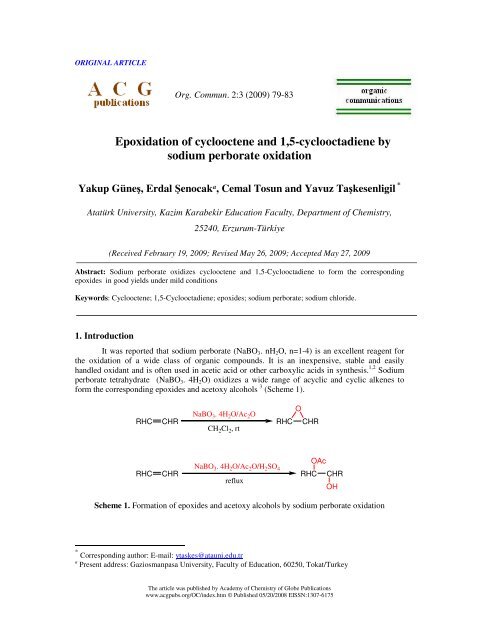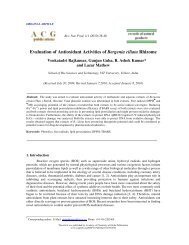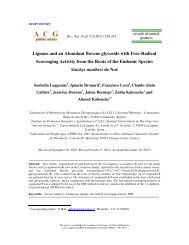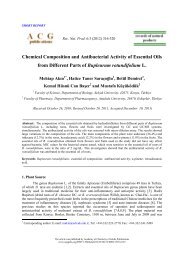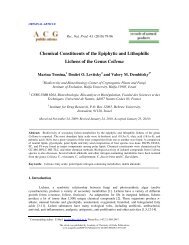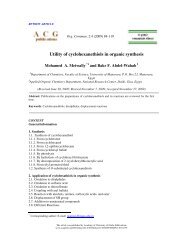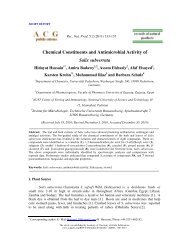Epoxidation of cyclooctene and 1,5-cyclooctadiene by sodium ...
Epoxidation of cyclooctene and 1,5-cyclooctadiene by sodium ...
Epoxidation of cyclooctene and 1,5-cyclooctadiene by sodium ...
Create successful ePaper yourself
Turn your PDF publications into a flip-book with our unique Google optimized e-Paper software.
ORIGINAL ARTICLE<br />
Org. Commun. 2:3 (2009) 79-83<br />
<strong>Epoxidation</strong> <strong>of</strong> <strong>cyclooctene</strong> <strong>and</strong> 1,5-<strong>cyclooctadiene</strong> <strong>by</strong><br />
<strong>sodium</strong> perborate oxidation<br />
Yakup Güneş, Erdal Şenocak a , Cemal Tosun <strong>and</strong> Yavuz Taşkesenligil *<br />
Atatürk University, Kazim Karabekir Education Faculty, Department <strong>of</strong> Chemistry,<br />
25240, Erzurum-Türkiye<br />
(Received February 19, 2009; Revised May 26, 2009; Accepted May 27, 2009<br />
Abstract: Sodium perborate oxidizes <strong>cyclooctene</strong> <strong>and</strong> 1,5-Cyclooctadiene to form the corresponding<br />
epoxides in good yields under mild conditions<br />
Keywords: Cyclooctene; 1,5-Cyclooctadiene; epoxides; <strong>sodium</strong> perborate; <strong>sodium</strong> chloride.<br />
1. Introduction<br />
It was reported that <strong>sodium</strong> perborate (NaBO3. nH2O, n=1-4) is an excellent reagent for<br />
the oxidation <strong>of</strong> a wide class <strong>of</strong> organic compounds. It is an inexpensive, stable <strong>and</strong> easily<br />
h<strong>and</strong>led oxidant <strong>and</strong> is <strong>of</strong>ten used in acetic acid or other carboxylic acids in synthesis. 1,2 Sodium<br />
perborate tetrahydrate (NaBO3. 4H2O) oxidizes a wide range <strong>of</strong> acyclic <strong>and</strong> cyclic alkenes to<br />
form the corresponding epoxides <strong>and</strong> acetoxy alcohols 3 (Scheme 1).<br />
O<br />
NaBO3. 4H2O/Ac2O RHC CHR RHC CHR<br />
CH2Cl2, rt<br />
RHC CHR<br />
NaBO 3. 4H 2O/Ac 2O/H 2SO 4<br />
reflux<br />
OAc<br />
RHC CHR<br />
Scheme 1. Formation <strong>of</strong> epoxides <strong>and</strong> acetoxy alcohols <strong>by</strong> <strong>sodium</strong> perborate oxidation<br />
* Corresponding author: E-mail: ytaskes@atauni.edu.tr<br />
a Present address: Gaziosmanpasa University, Faculty <strong>of</strong> Education, 60250, Tokat/Turkey<br />
The article was published <strong>by</strong> Academy <strong>of</strong> Chemistry <strong>of</strong> Globe Publications<br />
www.acgpubs.org/OC/index.htm © Published 05/20/2008 EISSN:1307-6175<br />
OH
epoxidation <strong>of</strong> <strong>cyclooctene</strong> <strong>and</strong> 1,5-<strong>cyclooctadiene</strong><br />
A combination <strong>of</strong> <strong>sodium</strong> perborate <strong>and</strong> <strong>sodium</strong> bromide have been used for the bromination <strong>of</strong><br />
alkenes 4 <strong>and</strong> alkynes 5 in acetic acid at room temperature <strong>and</strong> obtained the corresponding vicinal<br />
dibromo alkanes <strong>and</strong> trans-dibromo alkenes in good yields (Scheme 2). At high temperatures,<br />
bromination <strong>of</strong> alkenes results predominantly in the formation <strong>of</strong> solvolytic bromo derivatives,<br />
such as bromohydrines, bromo acetates, <strong>and</strong> acetoxy alcohols, <strong>by</strong> using this new bromination<br />
agent. 6<br />
RHC CHR<br />
R<br />
C C R<br />
NaBO 3 . 4H 2O/NaBr<br />
HOAc, rt<br />
NaBO 3 . 4H 2O/NaBr<br />
AcOH, rt<br />
Br<br />
RHC CHR<br />
R<br />
Br<br />
Br<br />
C C<br />
Scheme 2. Bromination <strong>of</strong> alkenes <strong>and</strong> alkynes using <strong>sodium</strong> perborate <strong>and</strong> <strong>sodium</strong> bromide<br />
mixture<br />
Recently, we have reported that <strong>sodium</strong> perborate oxidatively chlorinates a variety <strong>of</strong><br />
alkenes with <strong>sodium</strong> chloride as the chlorine source in acetic acid at room temperature to form βchlorohydrins<br />
<strong>and</strong> vicinal acetoxy alcohols as main products (Scheme 3). 7<br />
Cl<br />
NaBO3. 4H2O/NaCl RHC CHR RHC CHR<br />
AcOH, rt<br />
OH<br />
Br<br />
R<br />
OAc<br />
RHC CHR<br />
Scheme 3. Reaction <strong>of</strong> alkenes with <strong>sodium</strong> perborate <strong>and</strong> <strong>sodium</strong> chloride mixture<br />
In the present work, we report that <strong>sodium</strong> perborate oxidation <strong>of</strong> <strong>cyclooctene</strong> <strong>and</strong> 1,5<strong>cyclooctadiene</strong><br />
in the presence or in the absence <strong>of</strong> <strong>sodium</strong> chloride results in the formation <strong>of</strong> the<br />
corresponding epoxides in good yields.<br />
2. Results <strong>and</strong> Discussion<br />
In a previous paper, we have shown that the reaction <strong>of</strong> cyclohexene, cycloheptene<br />
benzonorbornadiene <strong>and</strong> styrene with <strong>sodium</strong> perborate <strong>and</strong> <strong>sodium</strong> chloride mixture results in<br />
the formation <strong>of</strong> solvolytic products such as chlorohydrins, acetoxy alcohols, etc. 7 Epoxides were<br />
not detected in any trace in these reactions. From the reaction <strong>of</strong> <strong>cyclooctene</strong> with <strong>sodium</strong><br />
perborate we have obtained totally different results. When <strong>cyclooctene</strong> was treated with a mixture<br />
<strong>of</strong> <strong>sodium</strong> perborate <strong>and</strong> <strong>sodium</strong> chloride in glacial acetic acid at room temperature, 1,2epoxycyclooctane<br />
2 was formed as the sole product in a yield <strong>of</strong> 79% (Scheme 4). In order to<br />
reveal the effect <strong>of</strong> <strong>sodium</strong> chloride on epoxidation, the reaction was carried out in the absence <strong>of</strong><br />
NaCl <strong>and</strong> again epoxycyclooctane 2 was obtained as the only oxidation product (Scheme 4). 1 H-<br />
<strong>and</strong> 13 C NMR spectra <strong>of</strong> 2 were identical with those reported. 8<br />
+<br />
OH<br />
80
81<br />
Güneş et al., Org. Commun. (2009) 2:3 79-83<br />
NaBO 3. 4H 2O/NaCl<br />
AcOH, rt<br />
1 2<br />
NaBO 3. 4H 2O<br />
AcOH, rt<br />
Scheme 4. Reaction <strong>of</strong> <strong>cyclooctene</strong> with <strong>sodium</strong> perborate<br />
Similar results were obtained from the reaction <strong>of</strong> 1,5-<strong>cyclooctadiene</strong> (3) with <strong>sodium</strong><br />
perborate. 1,5-Cyclooctadiene was subjected to oxidation <strong>by</strong> using one or two equivalent <strong>of</strong><br />
<strong>sodium</strong> perborate in glacial acetic acid at room temperature. In both cases, the known<br />
monoepoxide (4) 9,10 was formed as the only oxidation product in the presence or in the absence <strong>of</strong><br />
<strong>sodium</strong> chloride (Scheme 5).<br />
3<br />
NaBO 3. 4H 2O/NaCl<br />
AcOH, rt<br />
NaBO 3. 4H 2O<br />
AcOH, rt<br />
Scheme 5. Reaction <strong>of</strong> 1,5-<strong>cyclooctadiene</strong> with <strong>sodium</strong> perborate<br />
It was reported that most non-conjugated olefins react rather sluggishly with <strong>sodium</strong><br />
perborate in acetic acid at room temperature below ca. 40 o C, <strong>and</strong> this process is <strong>of</strong> little use for<br />
epoxidation. At high temperatures <strong>and</strong> with prolonged reaction times oxidation can be effected to<br />
give mixtures consisting mainly <strong>of</strong> epoxides <strong>and</strong> vicinal acetoxy alcohols <strong>and</strong> the active oxidizing<br />
agent under these conditions is probably peracetic acid. 2 However, admixture <strong>of</strong> <strong>sodium</strong> perborate<br />
with acetic anhydride in dichloromethane is reported to result in generation <strong>of</strong><br />
peroxybis(diacetoxy)borane, (AcO)2B-O-O-B(OAc)2, which reacts with alkenes to give epoxides<br />
in moderate to good yield (Scheme 1). 3 By taking literature mentioned above into consideration,<br />
we assume that peracetic acid is responsible for the epoxidation <strong>of</strong> <strong>cyclooctene</strong> <strong>and</strong> 1,5<strong>cyclooctadiene</strong><br />
<strong>and</strong> the epoxide formation <strong>by</strong> <strong>sodium</strong> perborate oxidation is special for<br />
cyclooctane ring.<br />
3. Conclusion<br />
In conclusion, we have shown in the present study that <strong>sodium</strong> perborate oxidizes<br />
<strong>cyclooctene</strong> <strong>and</strong> 1,5-Cyclooctadiene to form the corresponding epoxides in good yields under<br />
mild conditions <strong>and</strong> the active oxidizing agent under the applied reaction conditions may be<br />
peracetic acid <strong>and</strong> also revealed that <strong>sodium</strong> chloride has no effect on the oxidation processes.<br />
4<br />
O<br />
O
4. Experimental<br />
epoxidation <strong>of</strong> <strong>cyclooctene</strong> <strong>and</strong> 1,5-<strong>cyclooctadiene</strong><br />
General. 1 H <strong>and</strong> 13 C NMR spectra were recorded on 200 (50) <strong>and</strong> 400 (100)-MHz spectrometers.<br />
Column chromatography was performed on silica gel 60 (70-230 mesh, Merck). TLC was carried<br />
out on Merck 0.2 mm silica gel 60 F254 analytical aluminum plates. NaCl was purchased<br />
commercially from Merck.<br />
Reaction <strong>of</strong> Cyclooctene with Sodium Perborate <strong>and</strong> Sodium Chloride. 1.08 g (18.31 mmol)<br />
<strong>of</strong> <strong>sodium</strong> chloride was added to a mixture <strong>of</strong> <strong>sodium</strong> perborate (1.40 g, 9.09 mmol) <strong>and</strong><br />
<strong>cyclooctene</strong> (1.00 g, 9.07 mmol) in glacial acetic acid (25 mL) <strong>and</strong> stirred at room temperature for<br />
3 h. The mixture was then diluted with water (30 mL) <strong>and</strong> the aqueous solution was extracted<br />
with ether (3 x 60 mL), washed successively with saturated NaHCO3 solution (3 x 30 mL) <strong>and</strong><br />
water (3 x 30 mL) <strong>and</strong> dried over Na2SO4. After removal <strong>of</strong> the solvent, the residue was filtered<br />
on a short silica gel column (10.0 g) eluting with hexane-ethyl acetate (95:5) to give 0.90 g (79%)<br />
<strong>of</strong> epoxycyclooctane (2) as the sole product. Colorless oil; 1 H NMR (200 MHz, CDCl3) δ 2.86-<br />
2.76 (m, 2H), 2.13-2.06 (m, 2H), 1.55-1.13 (m, 10H); 13 C NMR (50 MHz, CDCl3) δ 57.18, 28.57,<br />
28.30, 27.61.<br />
Reaction <strong>of</strong> 1,5-Cyclooctadiene with Sodium Perborate <strong>and</strong> Sodium Chloride. The reaction<br />
was carried out at room temperature for 24 h as described above using 300 mg ( 2.77 mmol) <strong>of</strong><br />
1,5-Cyclooctadiene (3), 940 mg (6.06 mmol) <strong>of</strong> <strong>sodium</strong> perborate, 713 mg (12.19 mmol) <strong>of</strong><br />
<strong>sodium</strong> chloride <strong>and</strong> 15 mL <strong>of</strong> glacial acetic acid <strong>and</strong> after work-up the residue was filtered on a<br />
short silica gel column (10.0 g) eluting with hexane-ethyl acetate (9:1) to give 210 mg ( 61%) <strong>of</strong><br />
5,6-epoxy<strong>cyclooctene</strong> (4) as the sole product. Colorless oil; 1 H NMR (400 MHz, CDCl3) δ 5.55<br />
(m, 2H), 3.01 (m, 2H), 2.45-2.39 (m, 2H), 2.15-1.98 (m, 6H); 13 C NMR (100 MHz, CDCl3)<br />
δ 129.04, 56.93, 28.30, 23.87. 1 H-NMR data is agreement with data given in the literature. 11<br />
Acknowledgements<br />
The authors are indebted to the Department <strong>of</strong> Chemistry (Faculty <strong>of</strong> Education <strong>and</strong><br />
Faculty <strong>of</strong> Science) <strong>and</strong> Atatürk University for their financial support <strong>of</strong> this work.<br />
References<br />
[1] McKillop, A.; S<strong>and</strong>erson, W.R. Sodium perborate <strong>and</strong> <strong>sodium</strong> percarbonate: further applications<br />
in organic synthesis. J. Chem. Soc., Perkin Trans. 1 2000, 471-476.<br />
[2] McKillop, A.; S<strong>and</strong>erson, W.R. Sodium perborate <strong>and</strong> <strong>sodium</strong> percarbonate: Cheap, safe <strong>and</strong><br />
versatile oxidising agents for organic synthesis. Tetrahedron 1995, 51, 6145-6166.<br />
[3] Xie, G.; Xu, L.; Hu, J.; Ma, S.; Hou, W.; Tao, F. Sodium perborate oxidations <strong>of</strong> cyclic <strong>and</strong><br />
acyclic alkenes to oxiranes or vicinal acetoxy alcohols. Tetrahedron Lett. 1988, 29, 2967-2968.<br />
[4] Kabalka, G.W.; Yang, K.; Reddy, N.K.; Narayana, C. Bromination <strong>of</strong> alkenes using a mixture <strong>of</strong><br />
<strong>sodium</strong> bromide <strong>and</strong> <strong>sodium</strong> perborate. Synth. Commun. 1998, 28, 925-929.<br />
[5] Kabalka, G.W.; Yang, K. Bromination <strong>of</strong> alkynes with <strong>sodium</strong> perborate <strong>and</strong> <strong>sodium</strong> bromide.<br />
Synth. Commun. 1998, 28, 3807-3809.<br />
[6] Senocak, E.; Taskesenligil, Y.; Tümer, F. Bromination <strong>of</strong> benzonorbornadiene using a mixture <strong>of</strong><br />
<strong>sodium</strong> bromide <strong>and</strong> <strong>sodium</strong> perborate at high temperatures. Turk. J. Chem. 2002, 26, 939-945.<br />
[7] Senocak, E.; Taskesenligil, Y.; Tümer, F.; Kazaz, C. Reactions <strong>of</strong> alkenes with <strong>sodium</strong> perborate<br />
<strong>and</strong> <strong>sodium</strong> chloride. Turk. J. Chem. 2005, 29, 679-685.<br />
[8] http://www.sigmaaldrich.com/spectra/fnmr/FNMR009626.PDF, (accessed on February 2009)<br />
82
83<br />
Güneş et al., Org. Commun. (2009) 2:3 79-83<br />
[9] Hodgson, D.M.; Galano, J.M.; Christlieb, M. Synthesis <strong>of</strong> (-)-xialenon A <strong>by</strong> enantioselective αdeprotonation-rearrangement<br />
<strong>of</strong> a meso-epoxide. Tetrahedron 2003, 59, 9719-9728.<br />
[10] Hodgson, D.M.; Cameron, I.D.; Christlieb, M.; Green, R.; Lee, G.P.; Robinson, L.A.<br />
Functionalised bicyclic alcohols <strong>by</strong> enantioselective α-deprotonation-rearrangement <strong>of</strong> meso<br />
epoxides. J. Chem. Soc., Perkin Trans.1 2001, 2161-2174.<br />
© 2009 Reproduction is free for scientific studies


